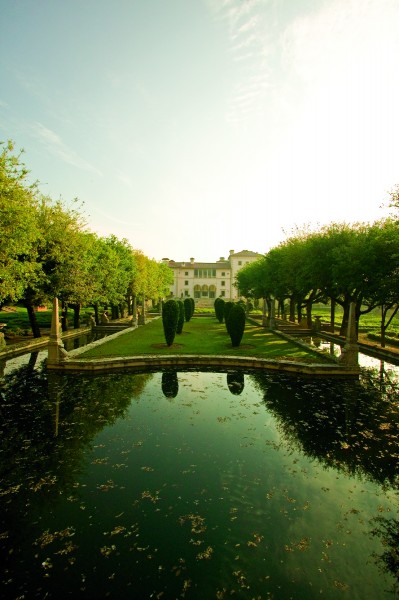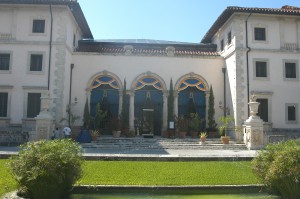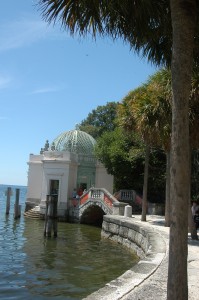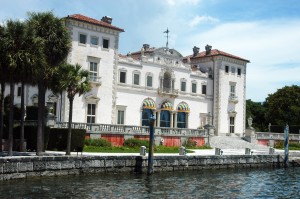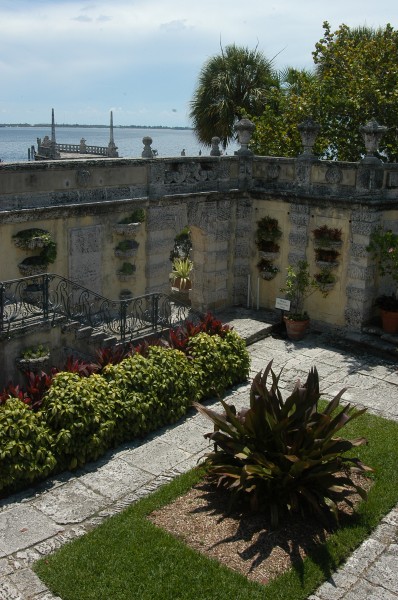Posted November 6, 2012
By ROBERT PURSELL
MIAMI, Fla. — When I first drove up to the gates of Vizcaya Museum and Gardens, two things came to my mind. The first, was that given the setting, I almost felt underdressed in my shorts and flip-flops.
The driveway itself seemed too formal for my attire, with its perfectly manicured hedges and authentic marble Venetian statues that spot the ride into the estate. The second thought I had, was that somehow in between the drive from my apartment in downtown Miami and this estate in Coconut Grove, I had managed to land myself inside the pages of “The Great Gatsby.”
Sprawled out over 54 acres, the Vizcaya Museum and Gardens seems almost too beautiful to be true. It seems too large, too picturesque, and too ornate to be a real place. It feels like something out of a Disney movie.
Lines of green Australian Pine plants run up to the manor, interspersed throughout by coral fountains jutting up out of the shrubbery.
The estate was built between the years of 1914 and 1916 by the early 20th century industrialist James Deering, as a place for him to live in the winter. It became famous for its elaborate Venetian design and the ornate flourishes that were incorporated into its construction. It boasts polished marble floors that lie beneath fresco covered ceilings. During his time living in the estate, James Deering made it a point, much like the fictional Jay Gatsby, of throwing lavish parties and gatherings at his house.
“It really is quite remarkable,” said Rebecca Peterson, the director of Public Programming at Vizcaya, “How many similarities people draw between Deering’s life here and Gatsby. The whole idea of an eternal bachelor throwing parties on his lavish property. It really is incredible.”
According to Peterson, hundreds would often show to his parties. During the Prohibition Era, Deering and others would smuggle liquor into the estate to help liven up the parties. Often times, his guests included more than just your run-of-the-mill crowd.
“His parties used to attract all sorts of celebrities,” she said. “The old film star Lillian Gish was a regular, as was Thomas Edison. Even President Warren G. Harding made a few visits to Vizcaya during his time in office.”
But one of Deering’s favorite pastimes, according to Peterson, was showing movies to his houseguests.
“He used to this program called Pathoscope,” said Peterson. “It was like the great-grandfather of Netflix. He was sent five new reels of film each week, which he took great pride in showing to large crowds.”
I set off on a quest to see just what it would be like to attend one of Mr. Deering’s movie nights…
I arrived at the estate about a half hour early for the film’s 7 p.m. show time and was told by one of the attendants that I could walk around the grounds to pass the time until the movie began. I began by walking through the formal gardens to the south of the estate. It seemed as though I had stepped into some fairy tale; I walked through a labyrinth maze of emerald hedges that were watched over by Venetian white marble statues of the Greek Gods, each one hundreds of years old, that Deering had flown in to decorate his estate.
Limestone and coral garden houses concealed spiral staircases that led down to the waterways that surround the estate; each one shrouded in mangroves and leading off into Biscayne Bay. I walked to the orchid gardens at the northern end of the estate, where Deering, due to his love of horticulture, had planted thousands upon thousands of brightly hued orchids amongst stone columns and walkways.
With the show time nearing, I walked down to the private dock on the eastern end of the property. I took off my shoes and dangled my feet off the coral steps that dive down into Biscayne Bay and looked across the picturesque water. In my mind, I imagined myself yet again to be Jay Gatsby, staring out across the water at some flashing green light off in the distance. After staring blankly into the distance for a while I decided to get back into the villa to view the film.
We would be watching the 1925 silent horror film “The Phantom of The Opera,” starring screen legend Lon Chaney. Before the movie began, I was told that, in order to truly recreate the viewing experience of one of Mr. Deering’s guests, there would be an orchestral organist playing along with the film.
Mr. Deering, it seemed, spared no expense in providing entertainment to his guests, and had a fully philharmonic organ installed to play along with the silent films of the era. I sat on the marble floors of the courtyard underneath a glass ceiling and watched as the story unfolded.
Without the help of dialogue, I began to feel my pulse ebb and flow with the pace and tone of the orchestra. I laughed, along with the crowd, at the melodramatic acting that was required of the actors when they didn’t have dialogue to convey emotions.
I sat, in awe, at just how terrifying of a face Lon Chaney was able to make without the help of modern makeup and special effects. I was lost in the magic of the film. The singing of the organ and the emotional responses of the crowd filled the resulting silence from lack of dialogue. We laughed when a patron would slowly tip-toe into an opera hall dressing room and gasped every time Lon Chaney would show his disfigured face.
We held our breaths at every shadow and chuckled at the special effects of the early 20th century. Most importantly though, when the movie was over, we all stood up and applauded.
“I would do this again in a heartbeat,” said Cathy Weissinger, a program coordinator for a local nonprofit organization. “It was like taking a trip back in time.”
According to Peterson, this type of response is typical for first-time visitors to Vizcaya.
“What makes this place so special,” she said, “is that it stands as a living testament to an interesting time in history where past and present collided to create one, giant, spectacular setting.”
IF YOU GO
• Tickets for special shows are $15. Tickets for regular day admissions are $10.
• Parking on the premises is free.
• Take South Dixie Highway to Bayshore Drive and follow it all the way until you see the entrance, or simply take the Metrorail and get off at the Vizcaya stop.
• Showtimes as well as other information is available at vizcayamuseum.org

